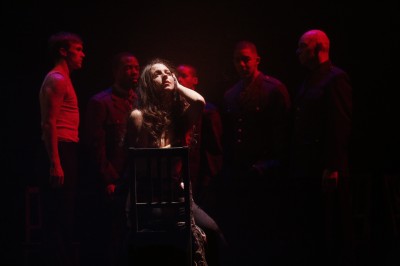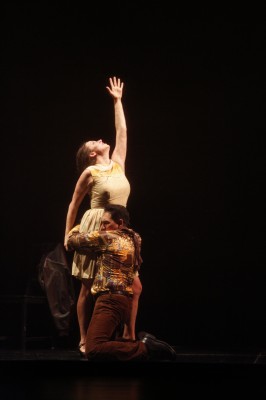Maria de Buenos Aires
Book by Horacio Ferrer
Direction by Andreas Mitisek
Choreographer by Gustavo Ramírez Sansano
Starring Gregorio Luke, Peabody Southwell, Gregorio Gonzalez, & Mark Bringelson
This erotic phantasmagoria is a bold re-imagining of Piazzolla’s tango operita.
Austrian conductor Andreas Mitisek’s boldly conceived staging of Astor Piazzolla and Horacio Ferrer’s tango operita, Maria de Buenos Aires—now playing at the Harris Theater—lands like a phantom fist to the gut. Set to the sultry fluidity of the tango nuevo, this free-form adaptation of the original is a fierce piece of social realism which at once aspires to the dimensions of an expressionist myth.
This production—which had its original debut at the Long Beach Opera, where Mitisek has been Artistic and General Director since 2003—does make some notable changes from Piazzolla and Ferrer’s original piece, placing it, for instance, in the context of Argentina’s “Dirty War,” a period of widespread state repression which lasted from the mid-70s to the early 80s. In it, as many as 30,000 individuals—mostly trade unionists, students, socialists, and their sympathizers—were “disappeared,” taken by the government to be brutally imprisoned, tortured and executed.
At the beginning of Maria de Buenos Aires, Older Payador (Gregorio Luke) stops to remember his being young in the era of Argentine’s “Dirty War,” and how he’d once fallen in love with Maria—a woman born “one day when God was drunk” into the  poverty of Buenos Aires. But the affair would be quick, as the Younger Payador’s (Gregorio Gonzalez) involvements in Argentine’s revolutionary underground lead to his ultimate arrest by the police.
poverty of Buenos Aires. But the affair would be quick, as the Younger Payador’s (Gregorio Gonzalez) involvements in Argentine’s revolutionary underground lead to his ultimate arrest by the police.
Compelled to take to the streets of Buenos Aires, turning tricks where possible, Maria is raped and beaten by an agent of the state (Mark Bringelson) and taken down into the infernal subterranean catacombs of Buenos Aires, along with all the other “disappeared” victims of Argentina’s pervasive policy of state repression, including her lover, the Younger Payador. And there, bound and blindfolded and emptied of her personhood, Maria is tortured, humiliated, and eventually dies. A symbol of the violated body politic of the Argentine people—and also their indefatigable national anima—Maria’s body is then taken up by the people of Argentina and carried above their shoulders in a powerful evocation of the crucified Christ.
And this powerful re-imagining puts flesh on his and Piazzolla’s otherwise bare expressionist bones, embedding in its broadly symbolic personages the depth and richness of an actual historical and cultural milieu. And to this effect, Mitisek (along with video designer Adam Flemming) has employed a clever use of film, projecting scenes of violent insurrection and the faces of the Argentine “disappeared” across a thin scrim stretched across the entirety of the proscenium. And as the production shifts from documentary footage of Argentina in upheaval to the staged drama unfolding behind, we get the sense of a two-dimensional record deepening into actual three-dimensions (effortlessly, thanks to Dan Weingarten’s atmospheric stage lighting), enlivening to our senses and to our emotions some derived potency of that original moment in time.
And Peabody Southwell’s full-bodied mezzo performance as Maria is of a woman victimized though never herself a victim. With a lower register that swings like a curled fist, she’s also an emotional anchor sunk deep, providing us a clear-eyed way in to Mitisek’s otherwise nightmarish phantasmagoria. Also featuring the Luna Negra Dancers pulsating to the tango steps of Gustavo Ramirez Sansano’s beautiful choreography, Chicago Opera’s Maria de Buenos Aires is undoubtedly a one-of-a-kind theatrical event, as bold in its re-visioning of traditional theatrical and operatic forms as Piazzolla was in his re-visioning of the tango, itself.
HIGHLY RECOMMENDED
Reviewed by Anthony J. Mangini
Reviewed Wednesday, April 24th, 2013.
Running time is approximately 1 hour and 15 minutes with no intermission.
Maria de Buenos Aires runs Friday, April 26th and Sunday, April 28th, 2013. The Harris Theater is located at 205 E. Randolph, Chicago, IL 60601. For tickets call (312) 704-8414 or visit www.chicagooperatheater.org/. Check out their Theater in Chicago listing at https://www.theatreinchicago.com/maria-de-buenos-aires/6255/.

